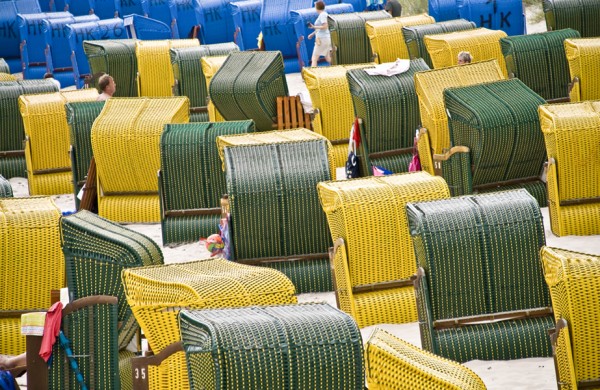![]()
contributed by Denise Homme, PhD, ASID, IIDA, IDEC, FCSD, NCIDQ Certificate Holder [DISD program director / practicing professional / itinerant traveler]
 The architect Ludwig Mies van der Rohe once said, “A chair is a very difficult object. A skyscraper is almost easier. That is why Chippendale is famous.” Even for a designer as accomplished as van der Rohe, the idea of designing and building something as difficult as a chair was considered a formidable task. Perhaps van der Rohe was right – engineering a piece of furniture to not only look good but to comfortably support the body is certainly not an undertaking to be taken lightly. Using only reclaimed or recycled materials for inspiration would logically make the “design-build-aha a chair” challenge an even more difficult task. If given the chance to design a chair and subtract from the over three thousand pounds of waste each person in the United States adds to the landfill each year, would you rise to the challenge” The interior design students at Design Institute of San Diego have and invite you to join them in making the world a little greener.
The architect Ludwig Mies van der Rohe once said, “A chair is a very difficult object. A skyscraper is almost easier. That is why Chippendale is famous.” Even for a designer as accomplished as van der Rohe, the idea of designing and building something as difficult as a chair was considered a formidable task. Perhaps van der Rohe was right – engineering a piece of furniture to not only look good but to comfortably support the body is certainly not an undertaking to be taken lightly. Using only reclaimed or recycled materials for inspiration would logically make the “design-build-aha a chair” challenge an even more difficult task. If given the chance to design a chair and subtract from the over three thousand pounds of waste each person in the United States adds to the landfill each year, would you rise to the challenge” The interior design students at Design Institute of San Diego have and invite you to join them in making the world a little greener.
If we consider what people use and throw away each day, it’s evident there’s an immense amount of inspiration to draw from when designing and building a chair of reclaimed materials…empty cans, bottles, construction waste, old papers and magazines, wire, string, cardboard to name but a few. An enormous palette perhaps but, really, could someone really design and build a chair from all this stuff” And, even if they could, why in the world would they”
The operative word here is “world.” If we consider that it is estimated a Styrofoam cup or a plastic water bottle takes around a million years to decompose or that, on the average, an aluminum can will be in a landfill for around 500 years, it starts making sense that designers start thinking critically about what they throw away and what they re-purpose into useable things that can benefit the world.
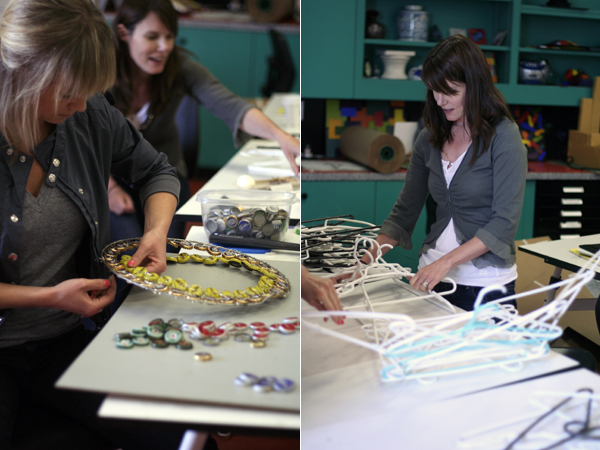
Quietly and without fanfare, Herman Miller has been thinking this way for decades. First, consider the incredible range of “Mid-Century” furniture classics that first began to emerge from the Hermann Miller factories in the 1950’s…chairs, tables, chaises and case goods that have taught us that when enduring quality and design innovation meet there’s no need to throw away and buy new. Then consider “Perfect Vision” – Herman Miller’s comprehensive plan targeting the attainment of an impressive series of significant environmentally responsible objectives by the year 2020. Some of the many notable goals Perfect Vision outlines are ZERO hazardous waste, ZERO landfill, and ZERO air emissions. This is design thinking that takes environmental responsibility to another level.
Of course, not everyone can or will aspire to becoming a furniture designer with Herman Miller. This is no reason for designers to allow themselves to not think responsibly about how their design efforts ultimately impact the planet. With this in mind, let’s see what might happen if a group of first year interior design students are challenged with the problem of designing and building a chair of reclaimed and recycled materials. What might the outcome be”
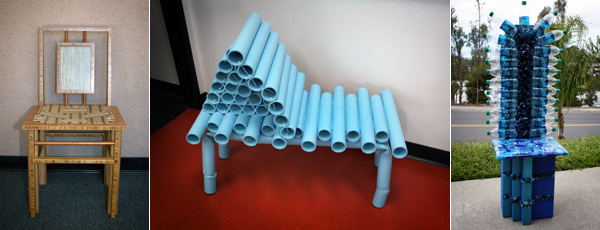
Fast forward to Spring semester 2010 at Design Institute of San Diego. As always, the weather is perfect – blue skies, a warm breeze is coming off the ocean and several interior design students are hard at work. Work tables throughout the studio are covered with rough sketches, balsa wood and cardboard. Several of the student designers are building scale models. What better way than building a model to analyze proportion and detail…or to try different ways of connecting and combining materials”
Conversation is lively. How, exactly, can this metal and this plywood be connected to create a chair that is aesthetically pleasing and, most importantly, that can hold weight” Having worked through both design and engineering issues in their scale model, some of the students are already engaged in building their full sized chairs. A burst of laughter erupts in the corner. Help, does anyone have some glue”
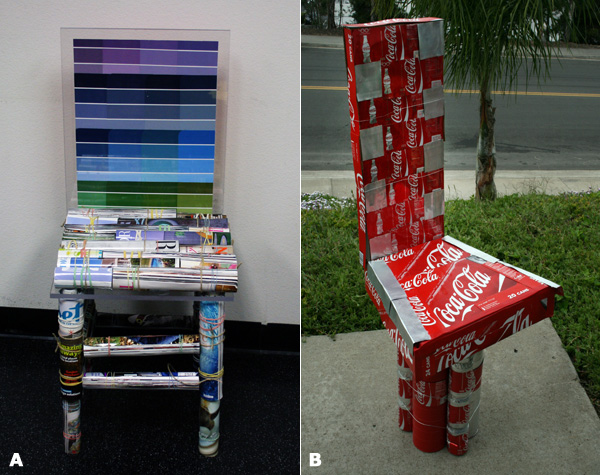
The day for final presentations has arrived and, as one might guess, the energy level in the design studio is remarkably high. Filled with anxious designers and an impressive assortment of chairs, the studio is alive with anticipation. A few last minute repairs here…a minor adjustment there. Would all these incredibly imaginative chairs stand up to the test” A team of spotters is standing by to insure that – in presenting the solution to this design challenge –one or more backsides do not unexpectedly engage with the floor.
Success! Each of the student designers has met this design challenge with a remarkably unique solution. It’s difficult to not be amazed by the range of materials used to build these chairs…old blue jeans, ATV tires, an old bed frame, left over spray paint, empty cereal boxes, zippers, thread, wood dowels, a tree trunk, old PVC pipe, cardboard scraps, tennis balls, bamboo, and some empty egg cartons, among other things. Truly an incredible assortment of recycled and reclaimed items that, until they were repurposed by these young designers into one of the world’s most universal objects, might have been destined for the local landfill.
Let’s take a look at what these designers have come up with. Here’s a unique way to re-use old magazines, paint chips, some rubber bands, PVC pipe, and sisal twine (Photo A). At a loss for how to re-purpose those old Coca Cola cans and boxes and those scraps of plywood you’ve had in the garage (Photo B)” Have an excess of plastic coat hangers in your closet and some old fishing line (Photo C)” Considering reusing all those bottle caps and hubcaps you’ve been collecting (Photo D)” That old surfboard you’ve been thinking about tossing out – here’s a new way to use it (Photo E).
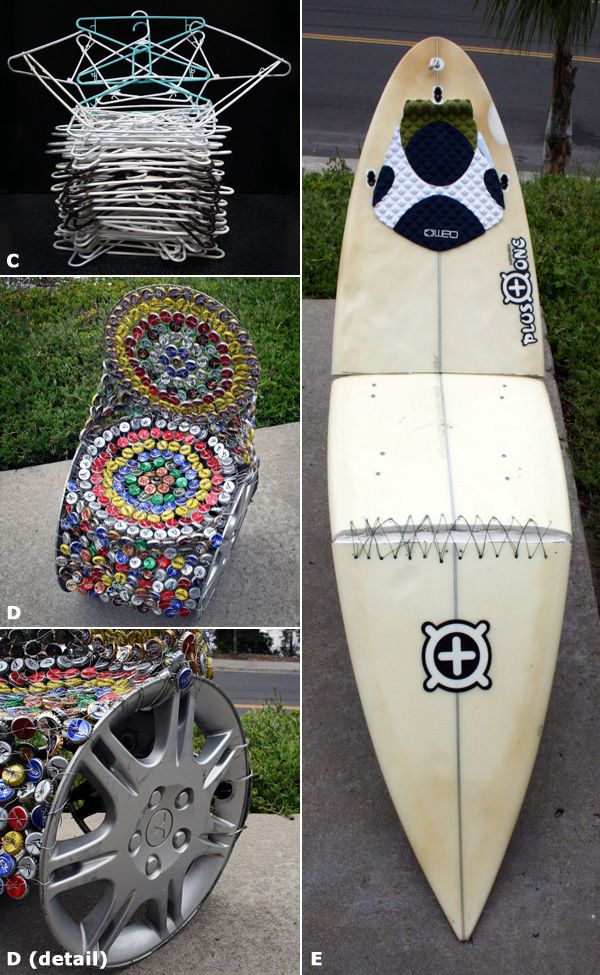
For more information about other interesting things the students at Design Institute of San Diego do – in addition to designing and building chairs from recycled and reclaimed materials – visit disd.edu.

